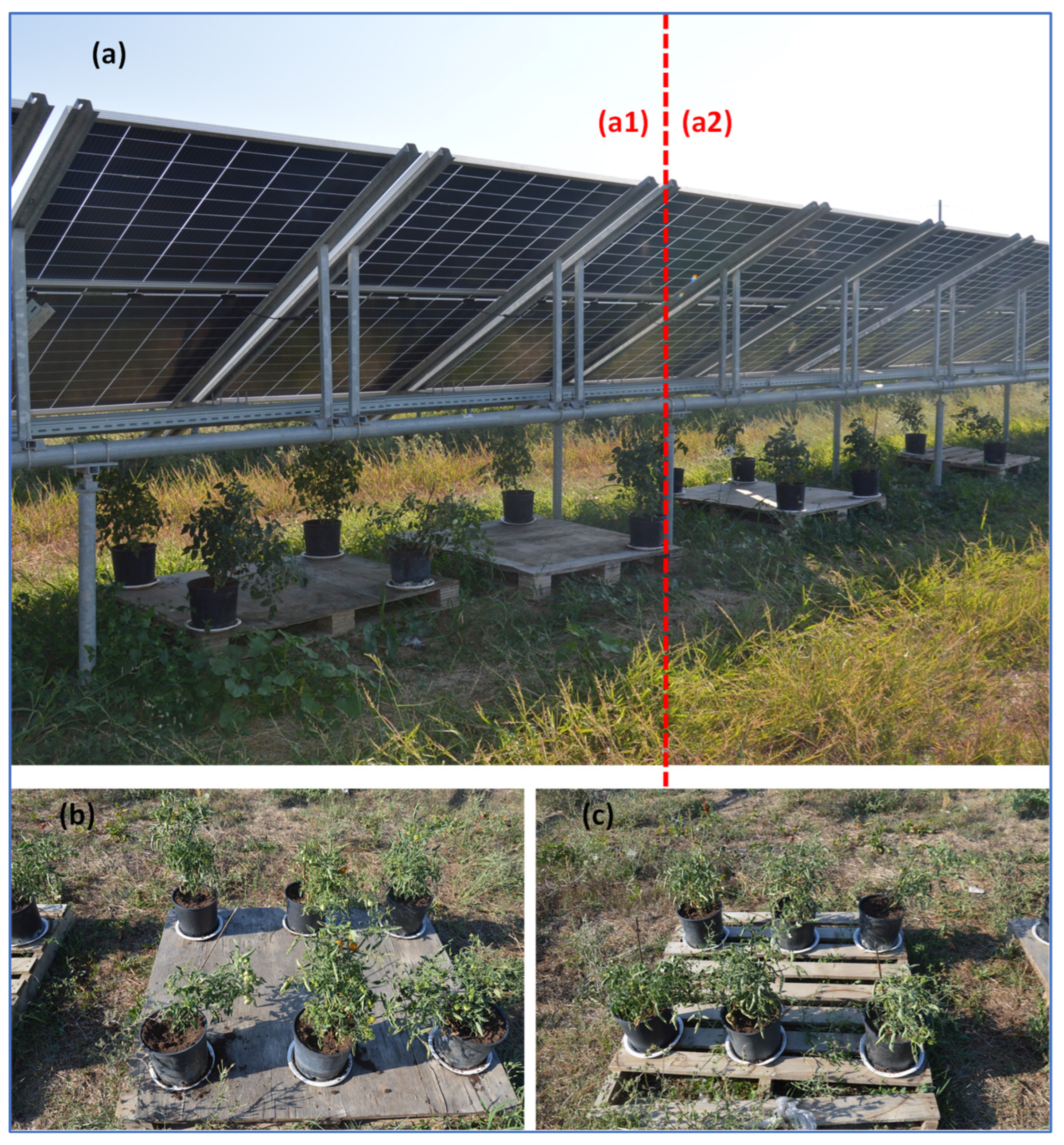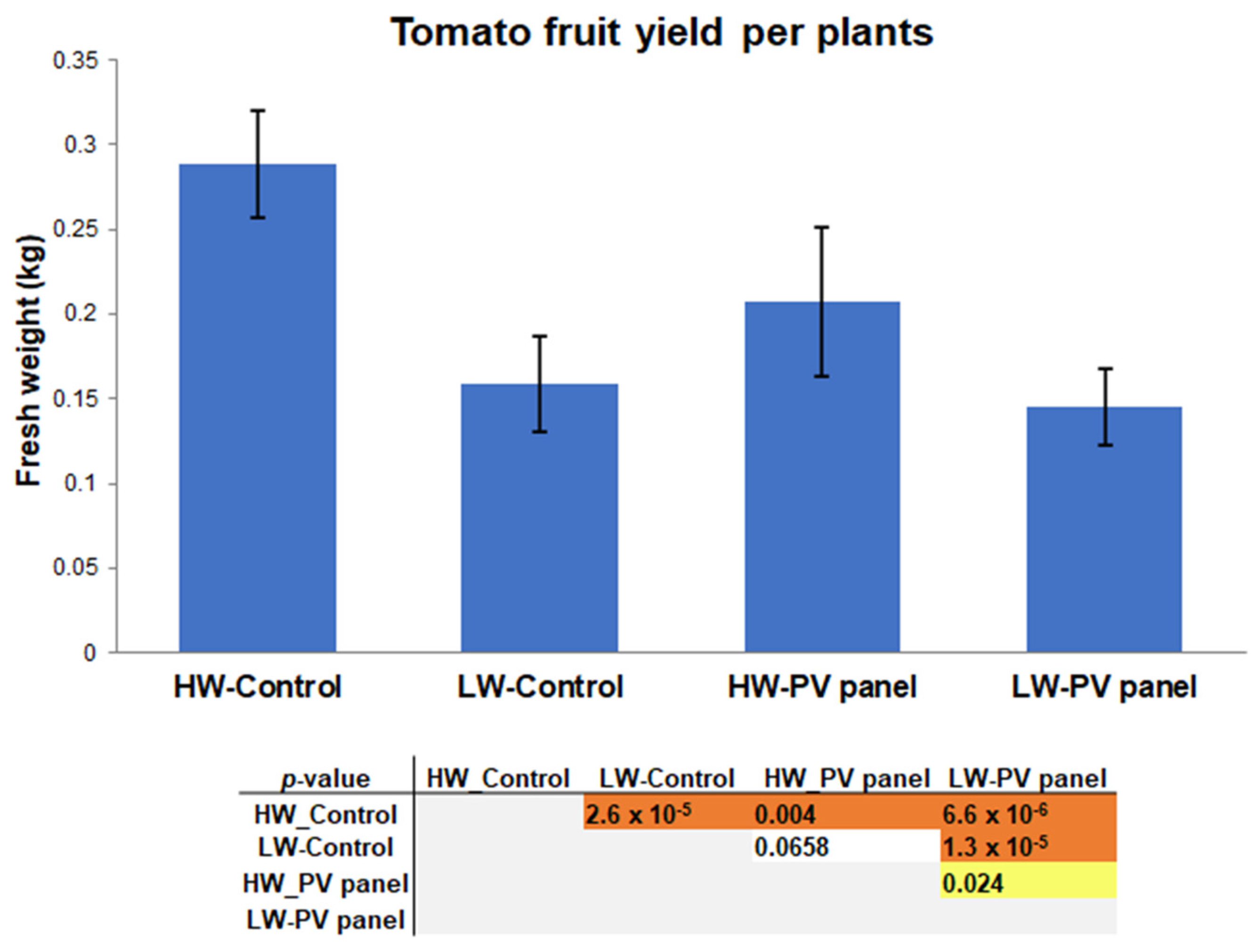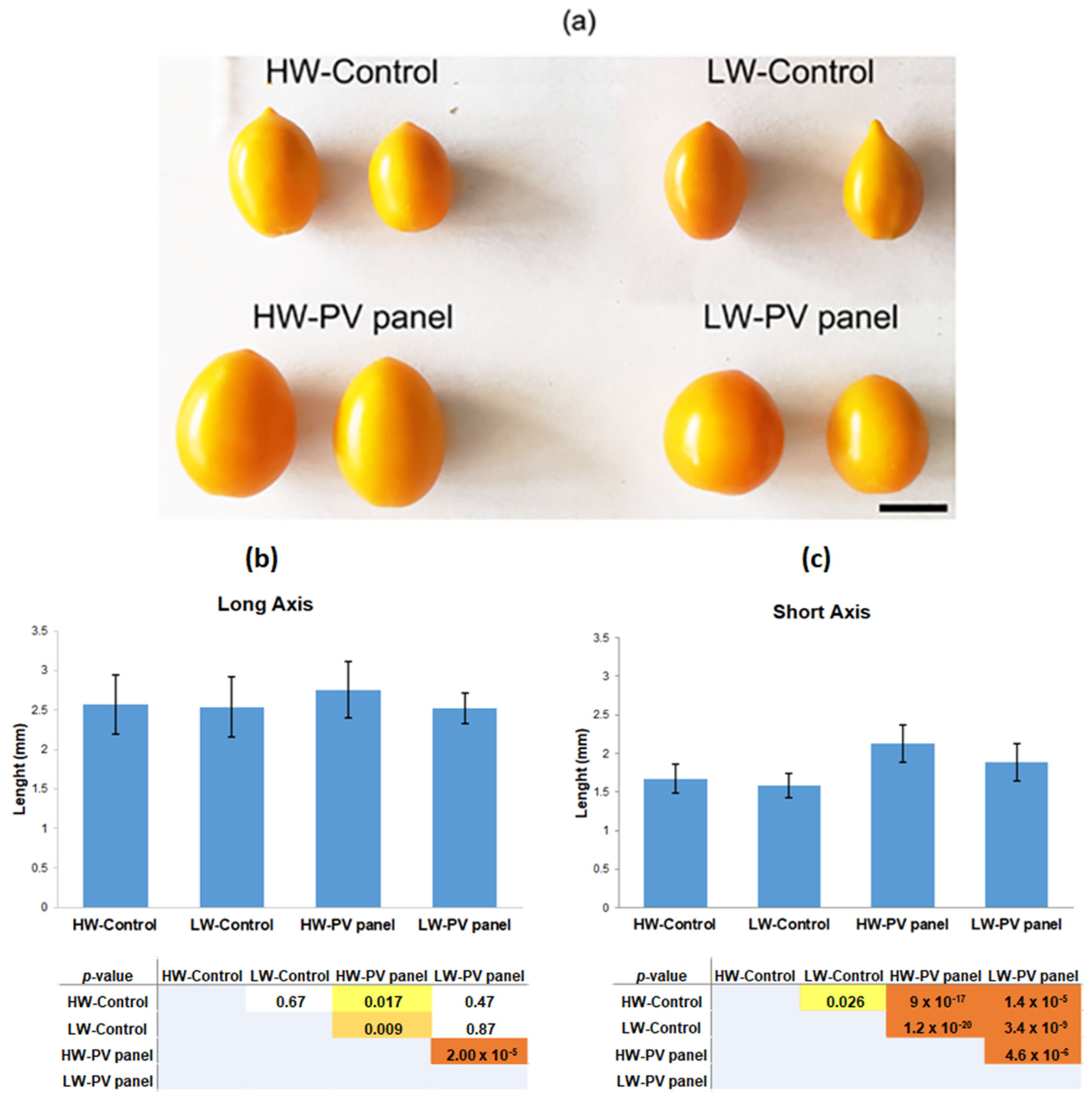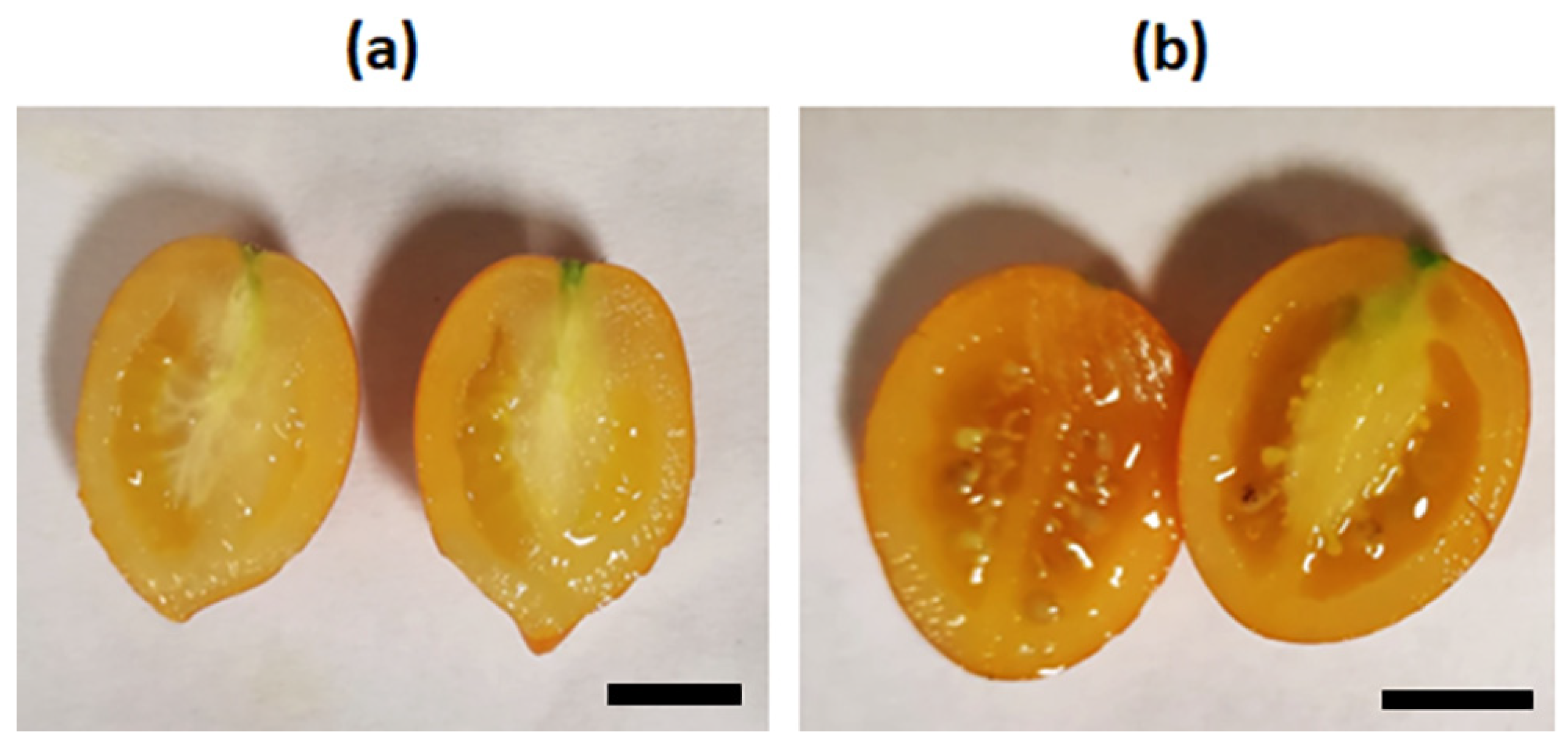Effects of the Agrivoltaic System on Crop Production: The Case of Tomato (Solanum lycopersicum L.)
Abstract
Featured Application
Abstract
1. Introduction
2. Materials and Methods
2.1. Conditions of Plant Growth
2.2. Yield, Morphometric, and Quality Analyses
2.3. Statistical Analysis
3. Results
3.1. Tomato Fruit Yield Grown under Different Light Exposures and Watering Regimes
3.2. Morphometric Features and Tomato Fruit Quality Assessment
3.3. Morphometric Features and Quality Assessment of Commercial Tomato Fruits
3.4. Environmental Conditions
4. Discussion
5. Conclusions
Author Contributions
Funding
Institutional Review Board Statement
Informed Consent Statement
Data Availability Statement
Acknowledgments
Conflicts of Interest
References
- Moonen, A.C.; Bàrberi, P. Functional biodiversity: An agroecosystem approach. Agric. Ecosyst. Environ. 2008, 127, 7–21. [Google Scholar] [CrossRef]
- Tan, P.Y.; Zhang, J.; Masoudi, M.; Alemu, J.B.; Edwards, P.J.; Grêt-Regamey, A.; Richards, D.R.; Saunders, J.; Song, X.P.; Wong, L.W. A conceptual framework to untangle the concept of urban ecosystem services. Landsc. Urban Plan 2020, 200, 103837. [Google Scholar] [CrossRef] [PubMed]
- Semeraro, T.; Turco, A.; Arzeni, S.; La Gioia, G.; D’Armento, R.; Taurino, R.; Medagli, P. Habitat Restoration: An Applicative Approach to “Biodiversity Heritage Relicts” in Social-Ecological Systems. Land 2021, 10, 898. [Google Scholar] [CrossRef]
- Semeraro, T.; Scarano, A.; Leggieri, A.; Calisi, A.; De Caroli, M. Impact of Climate Change on Agroecosystems and Potential Adaptation Strategies. Land 2023, 12, 1117. [Google Scholar] [CrossRef]
- FAO. The State of Food Security and Nutrition in the World: Building Climate Resilience for Food Security and Nutrition; Food and Agriculture Organization of the United Nations: Rome, Italy, 2018. [Google Scholar]
- HLPE. Food Security and Nutrition: Building a Global Narrative towards 2030; FAO: Rome, Italy, 2020; 112p, Available online: https://www.fao.org/3/ca9731en/ca9731en.pdf (accessed on 5 May 2022).
- Mirzabev, A.; Kerr, R.B.; Hasegawa, T.; Pradhan, P.; Wreford, A.; von der Pahlen, M.C.T.; Gurney-Smith, H. Severe climate change risks to food security and nutrition. Clim. Risk Manag. 2023, 39, 100473. [Google Scholar] [CrossRef]
- IPCC. Managing the Risks of Extreme Events and Disasters to Advance Climate Change Adaptation. A Special Report of Working Groups I and II of the Intergovernmental Panel on Climate Change; Field, C.B., Barros, V.R., Dokken, D.J., Mach, K.J., Mastrandrea, M.D., Bilir, T.E., Chatterjee, M., Ebi, K.L., Estrada, Y.O., Genova, R.C., et al., Eds.; Cambridge University Press: Cambridge, UK; New York, NY, USA, 2012; 582p. [Google Scholar]
- UNESCO. UNWater 2020: United Nations World Water Development Report 2020: Water and Climate Change; UNESCO: Paris, France, 2020; Available online: https://www.unesco.org/en/wwap/wwdr/2020 (accessed on 5 January 2024).
- Dixon, G. Chapter 17—The Impact of Climate and Global Change on Crop Production. In Letcher, Climate Change; Trevor, M., Ed.; Elsevier: Amsterdam, The Netherlands, 2009; pp. 307–324. ISBN 9780444533012. [Google Scholar] [CrossRef]
- Habib-ur-Rahman, M.; Ahmad, A.; Raza, A.; Hasnain, M.U.; Alharby, H.F.; Alzahrani, Y.M.; Bamagoos, A.A.; Hakeem, K.R.; Ahmad, S.; Nasim, W.; et al. Impact of climate change on agricultural production; Issues, challenges, and opportunities in Asia. Front. Plant Sci. 2022, 13, 925548. [Google Scholar] [CrossRef] [PubMed]
- Scharff, L.B.; Saltenis, V.L.R.; Jenen, P.E.; Baekelandt, A.; Burgess, A.J.; Burow, M.; Ceriotti, A.; Cohan, J.-P.; Geu-Flores, F.; Halkien, B.A.; et al. Prospects to improve nutritional quality of crops. Food Energy Secur. 2021, 11, e327. [Google Scholar] [CrossRef]
- Wu, J.; Wang, J.; Hui, W.; Zhao, F.; Wang, P.; Su, C.; Gong, W. Physiology of Plant Responses to Water Stress and Related Genes: A Review. Forests 2022, 13, 324. [Google Scholar] [CrossRef]
- Wiréhn, L. Nordic agriculture under climate change: A systematic review of challenges, opportunities and adaptation strategies for crop production. Land Use Policy 2018, 77, 63–74. [Google Scholar] [CrossRef]
- Kumar, N.; Khurana, P.K. Potential Push of Climate Change on Crop Production, Crop Adaptation, and Possible Strategies to Mitigate This; Ansari, M.W., Singh, A.K., Tuteja, N., Eds.; Wiley: Hoboken, NJ, USA, 2023. [Google Scholar] [CrossRef]
- Amaducci, S.; Yin, X.; Colauzzi, M. Agrivoltaic systems to optimise land use for electric energy production. Appl. Energy 2018, 220, 545–561. [Google Scholar] [CrossRef]
- Semeraro, T.; Scarano, A.; Santino, A.; Emmanuel, R.; Lenucci, M. An innovative approach to combine solar photovoltaic gardens with agricultural production and ecosystem services. Ecosyst. Serv. 2022, 56, 101450. [Google Scholar] [CrossRef]
- Kumpanalaisatit, M.; Setthapun, W.; Sintuya, H.; Pattiya, A.; Jansri, S.N. Current status of agrivoltaic systems and their benefits to energy, food, environment, economy, and society. Sustain. Prod. Consum. 2022, 33, 952–963. [Google Scholar] [CrossRef]
- Lee, S.; Lee, J.; Jeong, Y.; Kim, D.; Seo, B.; Seo, Y.; Kim, T.; Choi, W. Agrivoltaic system designing for sustainability and smart farming: Agronomic aspects and design criteria with safety assessment. Appl. Energy 2023, 341, 121130. [Google Scholar] [CrossRef]
- Semeraro, T.; Scarano, A.; Curci, L.M.; Leggieri, A.; Lenucci, M.; Basset, A.; Santino, A.; Piro, G.; De Caroli, M. Shading effects in agrivoltaic systems can make the difference in boosting food security in climate change. Appl. Energy 2024, 358, 122565. [Google Scholar] [CrossRef]
- Dinesh, H.; Pearce, J.M. The potential of agrivoltaic systems. Renew. Sustain. Energy Rev. 2016, 54, 299–308. Available online: http://linkinghub.elsevier.com/retrieve/pii/S136403211501103X (accessed on 7 January 2024). [CrossRef]
- Adeh, E.H.; Selker, J.S.; Higgins, C.W. Remarkable agrivoltaic influence on soil moisture, micrometeorology and water-use efficiency. PLoS ONE 2018, 13, e0203256. [Google Scholar] [CrossRef]
- Mamun, M.A.A.; Dargusch, P.; Wadley, D.; Zulkarnain, N.A. A review of research on agrivoltaic systems. Renew. Sustain. Energy Rev. 2022, 161, 112351. [Google Scholar] [CrossRef]
- Kim, D.; Oren, R.; Qian, S.S. Response to CO2 enrichment of understory vegetation in the shade of forests. Glob. Chang. Biol. 2016, 22, 944–956. [Google Scholar] [CrossRef] [PubMed]
- Yang, F.; Fan, Y.; Wu, X.; Cheng, Y.; Liu, Q.; Feng, L.; Chen, J.; Wang, Z.; Wang, X.; Yong, T.; et al. Auxin-to-Gibberellin ratio as a signal for light intensity and quality in regulating soybean growth and matter partitioning. Front. Plant Sci. 2018, 9, 56. [Google Scholar] [CrossRef]
- Hitz, T.; Hartung, J.; Graeff-Hönninger, S.; Munz, S. Morphological response of soybean (Glycine max (L.) Merr.) cultivars to light intensity and red to far-red ratio. Agronomy 2019, 9, 428. [Google Scholar] [CrossRef]
- Rezazadeh, A.; Harkess, R.; Telmadarrehei, T. The Effect of Light Intensity and Temperature on Flowering and Morphology of Potted Red Firespike. Horticulturae 2018, 4, 36. [Google Scholar] [CrossRef]
- Lyu, X.; Mu, R.; Liu, B. Shade avoidance syndrome in soybean and ideotype toward shade tolerance. Mol. Breed. 2023, 43, 31. [Google Scholar] [CrossRef]
- Semchenko, M.; Lepik, M.; Cotzenberger, L.; Zobel, K. Positive effect of shade on plant growth: Amelioration of stress or active regulation of growth rate? J. Ecol. 2012, 100, 459–466. [Google Scholar] [CrossRef]
- Li, L.; Wang, H. Editorial: Shade avoidance syndrome in plants. Front. Plant Sci. 2022, 13, 990982. [Google Scholar] [CrossRef]
- Schweiger, A.H.; Pataczek, L. How to reconcile renewable energy and agricultural production in a drying world. Plants People Planet 2023, 5, 650–661. [Google Scholar] [CrossRef]
- Helyes, L.; Pek, Z.; Lugasi, A. Tomato Fruit Quality and Content Depend on Stage of Matyrity. HortScience 2006, 41, 1400–1401. [Google Scholar] [CrossRef]
- Mohammedi, S.; Dragonetti, G.; Admane, N.; Fouial, A. The Impact of Agrivoltaic Systems on Tomato Crop: A Case Study in Southern Italy. Processes 2023, 11, 3370. [Google Scholar] [CrossRef]
- Jarque, C.M.; Bera, A.K. A test for normality of observations and regression residuals. Int. Stat. Rev. 1987, 55, 163–172. [Google Scholar] [CrossRef]
- Royston, P. A remark on AS 181: The W-test for normality. Appl. Stat. 1995, 44, 547–551. [Google Scholar] [CrossRef]
- Sano, T.; Horie, H.; Matsunaga, A.; Hirono, Y. Effect of shading intensity on morphological and color traits and on chemical components of new tea (Camellia sinensis L.) shoots under direct covering cultivation. J. Sci. Food Agric. 2017, 98, 5666–5676. [Google Scholar] [CrossRef]
- Kottek, M.; Grieser, M.; Beck, C.; Rudolf, B.; Rubel, F. World Map of the Köppen-Geiger climate classification. Meteorol. Z. 2006, 15, 259–263. [Google Scholar] [CrossRef] [PubMed]
- Annual 2023 Global Climate Report. Temperature Anomalies Time Series. Available online: https://www.ncei.noaa.gov/access/monitoring/monthly-report/global/202313 (accessed on 1 October 2023).
- Copernicus 2023. Climate Change Services. Copernicus: 2023 Is the Hottest Year on Record, with Global Temperatures Close to the 1.5 °C Limit. Available online: https://climate.copernicus.eu/copernicus-2023-hottest-year-record (accessed on 1 October 2023).
- NOAA National Centers for Environmental Information. Monthly Global Climate Report for Annual 2023. Available online: https://www.ncei.noaa.gov/access/monitoring/monthly-report/global/202313/supplemental/page-1 (accessed on 29 January 2024).
- Thomas, B.; Vince-Prue, D. Photoperiodism in Plants, 2nd ed.; Academic Press: New York, NY, USA, 1997; pp. 1–26. [Google Scholar]
- AL-agele, H.A.; Proctor, K.; Murthy, G.; Higgins, C. A Case Study of Tomato (Solanum lycopersicon var. Legend) Production and Water Productivity in Agrivoltaic Systems. Sustainability 2021, 13, 2850. [Google Scholar] [CrossRef]
- Potenza, E. Studying the Impact of Agrivoltaic Systems across the Water-Energy-Food (WEF) Nexus; Università Cattolica del Sacro Cuore: Piacenza, Italy, 2021; Available online: http://hdl.handle.net/10280/146609 (accessed on 7 January 2024).
- Scarano, A.; Olivieri, F.; Gerardi, C.; Liso, M.; Chiesa, M.; Chieppa, M.; Frusciante, L.; Barone, A.; Santino, A.; Rigano, M.M. Selection of tomato landraces with high fruit yield and nutritional quality under elevated temperatures. J. Sci. Food Agric. 2020, 100, 2791–2799. [Google Scholar] [CrossRef] [PubMed]
- Tandon, K.S.; Baldwin, E.A.; Scott, J.W.; Shewfelt, R.L. Linking sensory descriptors to volatile and nonvolatile components of fresh tomato flavor. J. Food Sci. 2003, 68, 2366–2371. [Google Scholar] [CrossRef]
- Peet, M.M.; Harlow, C.D.; Larrea, E.S. Fruit quality and yield in five small-fruited greenhouse tomato cultivars under high fertilization regime. Acta Hort. 2004, 659, 811–818. [Google Scholar] [CrossRef]
- Thybo, A.K.; Edelenbos, M.; Christensen, L.P.; Sorensen, J.N.; Thorup-Kristensen, K. Effect of organic growing systems on sensory quality and chemical composition of tomatoes. LWT 2006, 39, 835–843. [Google Scholar] [CrossRef]
- Barrett, D.M.; Weakley, C.; Diaz, J.V.; Watnik, M. Qualitative and nutritional differences in processing tomatoes grown under commercial organic and conventional production systems. J. Food Sci. 2007, 72, C441–C451. [Google Scholar] [CrossRef]
- Aldrich, H.T.; Salandanan, K.; Kendall, P.; Bunning, M.; Stonaker, F.; Kulen, O.; Stushnoff, C. Cultivar choice provides options for local production of organic and conventionally produced tomatoes with higher quality and antioxidant content. J. Sci. Food Agric. 2010, 90, 2548–2555. [Google Scholar] [CrossRef]








| Treatment | Group (Light Conditions) | Plot (Watering Regime) |
|---|---|---|
| HW-Control | Full Sunlight | High |
| HW-PV Panel | PV Panel | High |
| LW-Control | Full Sunlight | Low |
| LW-PV Panel | PV Panel | Low |
Disclaimer/Publisher’s Note: The statements, opinions and data contained in all publications are solely those of the individual author(s) and contributor(s) and not of MDPI and/or the editor(s). MDPI and/or the editor(s) disclaim responsibility for any injury to people or property resulting from any ideas, methods, instructions or products referred to in the content. |
© 2024 by the authors. Licensee MDPI, Basel, Switzerland. This article is an open access article distributed under the terms and conditions of the Creative Commons Attribution (CC BY) license (https://creativecommons.org/licenses/by/4.0/).
Share and Cite
Scarano, A.; Semeraro, T.; Calisi, A.; Aretano, R.; Rotolo, C.; Lenucci, M.S.; Santino, A.; Piro, G.; De Caroli, M. Effects of the Agrivoltaic System on Crop Production: The Case of Tomato (Solanum lycopersicum L.). Appl. Sci. 2024, 14, 3095. https://doi.org/10.3390/app14073095
Scarano A, Semeraro T, Calisi A, Aretano R, Rotolo C, Lenucci MS, Santino A, Piro G, De Caroli M. Effects of the Agrivoltaic System on Crop Production: The Case of Tomato (Solanum lycopersicum L.). Applied Sciences. 2024; 14(7):3095. https://doi.org/10.3390/app14073095
Chicago/Turabian StyleScarano, Aurelia, Teodoro Semeraro, Antonio Calisi, Roberta Aretano, Caterina Rotolo, Marcello S. Lenucci, Angelo Santino, Gabriella Piro, and Monica De Caroli. 2024. "Effects of the Agrivoltaic System on Crop Production: The Case of Tomato (Solanum lycopersicum L.)" Applied Sciences 14, no. 7: 3095. https://doi.org/10.3390/app14073095
APA StyleScarano, A., Semeraro, T., Calisi, A., Aretano, R., Rotolo, C., Lenucci, M. S., Santino, A., Piro, G., & De Caroli, M. (2024). Effects of the Agrivoltaic System on Crop Production: The Case of Tomato (Solanum lycopersicum L.). Applied Sciences, 14(7), 3095. https://doi.org/10.3390/app14073095











